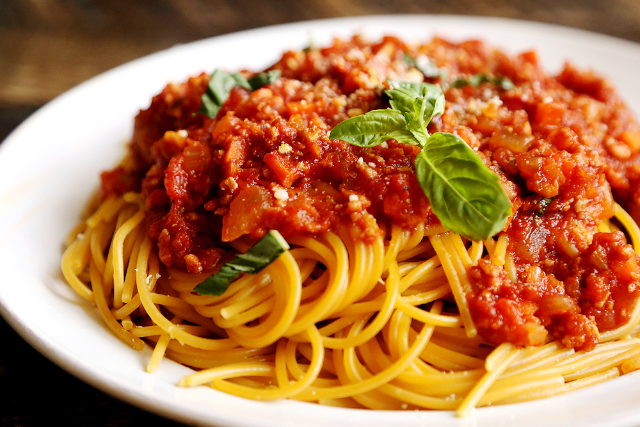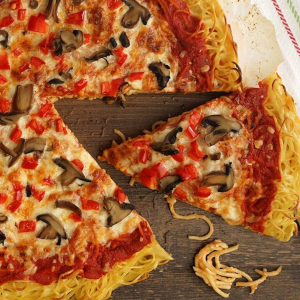Pasta has been enjoyed across the world for centuries. And it’s a core staple in some places. But have you thought of including at least one pasta dish a week in your cost-sensitive family menus? Pasta offers infinite opportunities to fill bellies healthfully!

Health concerns?
Pasta is very nutritious by itself. More so of paired with beans or legumes. Like potatoes, it’s what you put on it that makes it either better or worse dietarily. On the other hand, you can choose from dozens of commercial supermarket sauces and dine as healthfully as you wish. Better yet, get your own tomatoes – or grow then in your yard or in a flower box on your balcony – and control every aspect of its composition!
The secret’s in the sauce
I know. Prepared, jarred pasta sauces from the store may not rank among the healthiest choices for topping your pasta supper. But I was curious as to just what the nutrition picture for supermarket sauces looks like…
Let’s take as an example Classico di Napoli, a popular meatless commercial sauce found at many supermarkets. The ingredient list is fairly short, and sweet:
- Tomato products
- Water
- Onions
- Garlic
- Basil
- Olive Oil, and
- Black Pepper
The only preservatives used are citric acid and calcium chloride. Pretty basic, and mostly harmless.
Nutrition Facts…
The nutrition facts chart for the product say the stuff clocks in at only 45 Calories per serving. There’s no cholesterol or saturates fats (or transfats). And the sauce delivers significant doses of Calcium, Iron, Vitamin A and Vitamin C. Also on the up side, there’s only a trace added sugar.
The only issue is Salt. As with most savoury processed foods, there’s relatively a lot. Each 125 ml official serving contains 400 mg. And that’s 10 percent of your daily recommended intake. But let’s set that aside for now. You can moderate your intake of excess salt by choosing what you eat at others meals wisely.
Classico Sauces with meat (ie.- Italian Sausage Sauce w/ Peppers & Onions) weigh in at 60 Calories per serving. Almost all the other nutrients remain the same as in the non-meat varieties. But there is a slight increase in carbs and dietary fibre.
And sauces with meat may cost a little more.
The cost impact?
Classico sauces come in uniform 650 ml jars and the official serving suggestion is 0.5 cup / 125 ml. That works out to 5.2 servings per jar, which is difficult to work with mathematically. And I think that suggestion is a little slim. So let’s say we’re serving the usual 4 diners.
Most Classico varieties are regularly priced at around $5. That translates to $1.25 per serving. Not bad!
The pasta component
Most styles and forms of pasta are priced the same, by weight. Whether you want Spaghettini or Tagliatelle, Rotini or Oriccetti, the supermarket price for No Name or house brand pastas is uniformly around $2.99 for 2 lb. / 900 g. Divide that by 4 diners and you come up with just $0.75.
Be sure you buy whole-wheat pasta if you can get it, and your family doesn’t mind it. Much healthier.
So far, our pasta supper is ringing up at an even $2.00 per serving.
Additional stuff…
We recently ran a number of posts emphasizing the economy and nutritional goodness of the age-old Rice and Beans combo. Well, wheat is as much a grain as rice, and the same nutritional benefits accrue. If you add a can of beans of your choice to the sauce, you’re bulking it up and upping the nutritional value. You’re also upping the protein content. And you’re delivering a complete dietary protein without dabbling in expensive meat.
No Name or house branded beans are almost universally priced at around $1.50 a can. That adds a mere $0.38 to the cost of each serving, topping out the whole plate at $2.38 per serving.
Add a salad on the side?
Sure, if you can afford it. Keep it simple and use the least-expensive veggies you can get. Look up a recipe for a super-simple Italian Panzanella or Caprese salad, or Google the net for gazillions of other salads.
You might also want to splurge and top your pasta plates with some grated cheese. Again, if you can afford it, and if your family considers it essential.
The bottom line
I’ve used one sauce brand as my example in this post. The observations are just as valid for other brands. However, the numbers in the nutritional analyses may differ.
I’ve used a simple Spaghetti supper as my example today. Keep in mind you can use any pasta you want and any sauce you want. And you can use the same basic ingredients to create a Pomodoro, a Baked Zitti, or even a Spaghetti Pizza (see photo, top of page) or Spaghetti Pie! Feel free to add ingredients to the extent that your budget and palate can support.
And above all – enjoy your pasta guilt-free!
~ Maggie J.

